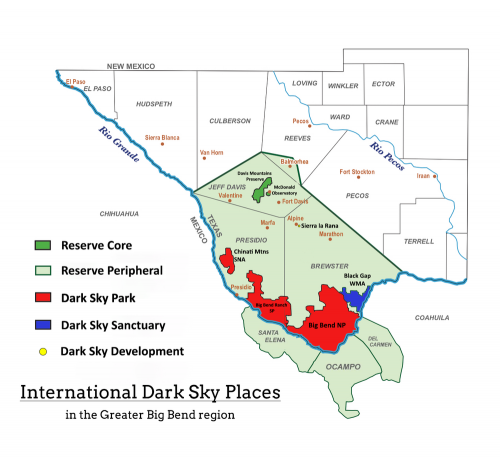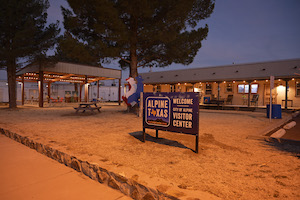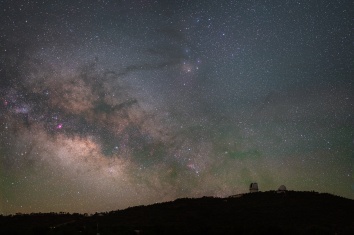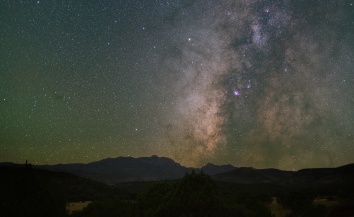McDonald Observatory Celebrates One-Year Anniversary of Greater Big Bend International Dark Sky Reserve
6 April 2023
FORT DAVIS, Texas -- This week, McDonald Observatory and numerous partners join in celebrating the first anniversary of the Greater Big Bend International Dark Sky Reserve. Covering more than 15,000 square miles in Texas and Mexico, the Reserve is the largest dark sky place in the world certified by the International Dark-Sky Association (IDA).

This achievement builds on a rich history of efforts to preserve the night skies in the region. McDonald Observatory's ongoing conservation work, including its support of the Reserve, has helped to ensure that it maintains the darkest skies of any research observatory in the continental United States.
“The Observatory has played a major role in informing, educating, and recognizing good lighting,” said Stephen Hummel, Dark Skies Initiative Coordinator at McDonald Observatory. “One of the biggest developments has been the Night-Sky Friendly Recognition Program, which recognizes the efforts of businesses and organizations who use good lighting and thus supports the broader Reserve.”

The Reserve was established through a diverse collaboration between communities, parks, and organizations. “These partnerships have been truly amazing for working together to preserve the night skies, which we all hold in such high regard,” said Kaylee French, the West Texas Education and Outreach Coordinator for The Nature Conservancy – a member of the Reserve.
Dark skies are crucial for preserving the natural beauty of the night sky and for reducing the negative impacts of light pollution on scientific observations, human health, wildlife, and the environment. “The daily cycle of light and dark is vital for the survival of all life on Earth in some way, shape, or form,” said French. Light pollution can disrupt ecosystems, interfere with the sleep patterns of humans and animals, and affect astronomical observations.
To assess light pollution levels in the Big Bend region, Hummel uses a method developed by the National Parks Service known as “all-sky photometry.” For these measurements, Hummel photographs the horizon and night sky above and works with the National Parks Service to stitch them together and isolate artificial light.
While light pollution is increasing by an estimated 9.6% annually in North America, Jeff Davis County presents a very different picture from the national average. Combining Hummel's measurements with contributions from volunteers using sky quality meters, the data reveal that the skies have become nearly 3% darker on average over the last year. “It’s progress, and we were a part of that change,” said Hummel.
A paper published earlier this year, “Light pollution indicators for all the major astronomical observatories” by Falchi et al., uses a different method to compare sky brightness above 28 major observatories across the globe. The authors used a model applied to the Visible Infrared Imaging Radiometer Suite (VIIRS) 2021 satellite radiance data to compute and analyze indicators of light pollution. These indicators include radiance at zenith, which you can think of as the point in the sky directly above your head, as well as other measures. The study calculated the percent change in sky radiance compared to the assumed natural background levels, and the results show the zenith night sky brightness at McDonald Observatory compares favorably with our peers. “It is reassuring to see the skies over McDonald Observatory as the darkest of any professional observatory on the North American continent in this comprehensive study” stated Taft Armandroff, Director of McDonald Observatory.
In collaboration with the IDA, McDonald Observatory will participate in Dark Sky Week from April 18-22, an annual event to raise awareness about the adverse effects of light pollution and the importance of preserving dark skies. During the week of celebrations, McDonald Observatory will host a series of events along with its regular programs, including pop-up labs and talks on topics ranging from archeoastronomy to nature’s need for darkness. Visitors may also participate in special tours of the observatory facilities and learn more about the state-of-the-art equipment used to study the night sky.
In addition to the exciting events planned for Dark Sky Week, McDonald Observatory is proud to continue showcasing the Preserving Dark Skies exhibit at the Frank N. Bash Visitors Center.
This exhibit, which opened in conjunction with the designation of the Greater Big Bend International Dark Sky Reserve last year, has been a popular attraction for visitors to the observatory. With an estimated 50,000 visitors having viewed the exhibit in the past year, Preserving Dark Skies has served as a vital tool for educating and raising awareness about the importance of protecting the night sky.
The exhibit's success has been made possible through funding from Apache Corp., who have been strong allies and champions of night sky-friendly lighting in the Permian Basin. McDonald Observatory extends its deepest gratitude to Apache Corp. for their unwavering support and partnership in preserving the natural beauty of the night sky and for their outstanding leadership in promoting the conservation of night skies.
McDonald Observatory encourages visitors to come and experience the wonders of West Texas's dark skies and practice night sky-friendly lighting. “There are lots of great things everyone can do to help,” said French. For more information on light pollution, the Greater Big Bend International Dark Sky Reserve, and the events at McDonald Observatory, visit mcdonaldobservatory.org.
About McDonald Observatory
McDonald Observatory is a research unit of The University of Texas at Austin and one of the world's leading centers for astronomical research, teaching, and public education and outreach. Observatory facilities are located atop Mount Locke and Mount Fowlkes in the Davis Mountains of West Texas, which offer some of the darkest night skies in the continental United States. Additionally, the observatory is a partner in the Giant Magellan Telescope under construction in Chile.
About the International Dark Sky Places Program
The International Dark Sky Places Program was founded in 2001 as a non-regulatory and voluntary program to encourage communities, parks, and protected areas around the world to preserve and protect dark sites through effective lighting policies, environmentally responsible outdoor lighting, and public education. When used indiscriminately, artificial light can disrupt ecosystems, impact human health, waste money and energy, contribute to climate change, and block our view and connection to the universe. Greater Big Bend IDSR now joins more than 195 Places that have demonstrated robust community support for dark sky advocacy and strive to protect the night from light pollution. Learn more by visiting http://www.darksky.org/conservation/idsp.
-- END --
Note to Editors:
Two broadcast-quality public service announcements are available for download.
PSA 1: https://utexas.app.box.com/s/41tx5g2u2r2vjnxz9wzpjsheiggoktmr/file/937640800253
PSA 2: https://utexas.app.box.com/s/41tx5g2u2r2vjnxz9wzpjsheiggoktmr/file/937641701018
Images:
Greater Big Bend International Dark Sky Reserve map
City of Alpine Visitors Center - Night Sky Friendly Lighting
Additional Contacts:
Teznie Pugh, Ph.D. Superintendent, McDonald Observatory
Phone: +1 432-426-4148
Email: super@astro.as.utexas.edu
Stephen Hummel Dark Skies Initiative Coordinator, McDonald Observatory
Phone: +1 432-426-4170
Email: stephenhummel@utexas.edu







